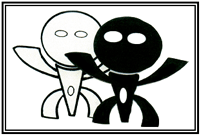The Way of The Kaihewalu 'Ohana Lua
At the young age of four, 'Ôlohe's father taught him how to step forward with the heel of the foot, and step backwards using the ball of the foot. This was the way of the Koa (warrior) who would walk silently so as not to alert his opponent. The Hula Ku'i Moloka'i was a very powerful hula (dance-like form) used to show how to use the hands, elbows, arms, legs, knees and foot movements along with various techniques used in the art of Lua. Because each bone joint is connected, this method of learning how to use all of the bone joints together as a “team” would later play a very important role in the family art of Kaihewalu 'Ohana Lua. Learning how to walk on a narrow tree branch would help to develop balance, body rhythm, and coordination. In the Kaihewalu Lua system, there are many empty– and open–handed techniques. Below is a list of just a few of the many open–handed weapon techniques based on both land and sea creatures, and are also used while in motion, as animal (Holoholona) forms:
In the Hâlau O Kaihewalu Lua System, the Ying and the Yang of the Chi Force is described in this manner: The woman represents the Negative Force and the man represents the Positive Force. These two opposite forces must connect and come into harmony with one's self. There are also two types of foundations in Kaihewalu Lua. The first foundation is the top half of the human body which represents the Negative Force (or the soft part). The second foundation is the bottom half (from the waist down) which represents the Positive Force (or the hard part) and is what helps move the top half. These two forces of the human body must join together to work as a team. The Kaihewalu Lua system incorporates the use of Peku (a variety of kicks), Paa Lima (hand catch and trap), Hikua (throws), Ku'i Ku'i (boxing; a variety of punches), Waho/Loko Hio (a variety of leg sweeps), Ihe Manamana Lima (finger spear poking), Pahu/Huki (push and pull), Nahu Waha (biting with the mouth), Ku'i (punch, poke), and Mokomoko (rough dirty, everything goes fighting). Throughout Hawaiian history there has been documented proof of drawings etched in rock depicting various meanings and symbols. The term Petroglyph refers to an image recorded on a stone, usually by prehistoric peoples, by means of carving, pecking or otherwise incised on natural rock surfaces. Commonly associated with Neolithic people, they were a dominant form or pre-writing symbols used in communication from approximately 10,000 B.C. to 5,000 B.C. The word comes from the Greek words petros meaning "stone" and glyphein meaning "to carve". In July of 1955, 'Ôlohe Kaihewalu created his family petroglyph (Kaha Ki'i) as part of the Kaihewalu 'Ohana Lua. It represents the negative (white) and positive (black) forces in the Kaihewalu Lua. Below is an interpretation of this Kaihewalu petroglyph: |
|
||
|
Po'o / Head = Keeping everything within and omit what is not needed. A unit generating power and looking for matter. Maka / Eye's = To cover the four corners of the earth which send information to the body parts and help record information at 12:00, 3:00, 6:00 and 9:00 o'clock. Lima / Arms–Hands = Weapons, plus extended working tools working as a team, sending the power of one's upper mass to its source, along with messages. Kino / Body = Tree trunk holding all the connecting forces together. Piko / Navel = A generator, brain, mass power, electrical power, or fuel to burn; consisting of the four elements. Wãwae / Leg = Hard working tool of lower mass used to extend the lower weapons. |
|
|
||
The Mana of the Kaihewalu 'Ohana Lua
It is the responsibility of the head of our 'Ohana Lua to observe, remember and bring the positive things into the 'Ohana Lua and omit those that are not. The eyes of our 'Ohana Lua are used to watch where we step in life so as not to upset others. We make sure we see where we are walking, rather than stepping forward or backwards blindly, so we do not trip or fall on those we do not see. The hands of our 'Ohana Lua are the children we embrace so they too can reach out and embrace and help others. They keep those from entering our home who want to cause problems. The bodies of our 'Ohana Lua must stay strong and healthy. The body is like a tree trunk with branches, stems and leaves representing how we walk, jump, run, and kick, but they must be nurtured and taken care of or they will die and be of no use. The brain and heart act as the center of the body to help store the knowledge and wisdom of our 'Ohana Lua. Considered as a whole, they form the body that keeps the family strong and together, and can reach out to others to help them by serving and sharing the food of our 'Ohana Lua. |


